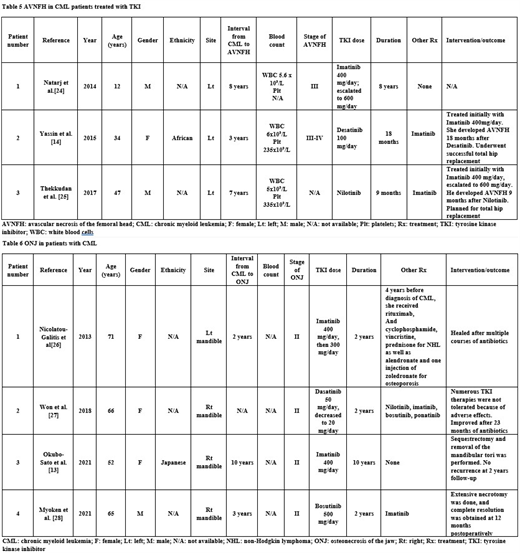Abstract
Introduction
Avascular necrosis (AVN) has been associated with hematological malignancies; nonetheless, it is extremely uncommon in patients with chronic myeloid leukemia (CML). AVN has been described as a presenting manifestation in few CML patients. In other cases, it has been linked to CML treatment, specifically interferon-alpha (IFN-α) and tyrosine kinase inhibitors (TKI). This article reviews the available published literature to shed light on the existing evidence focusing on the pathogenesis, clinical characteristics, and outcomes of AVN in patients with CML.
Results
after an extensive search in the literature, we found 17 cases of AVN of the femoral head (AVNFH) and four cases of osteonecrosis of the jaw (ONJ) in CML patients. We did not find any reported case of AVN with CML in other sites apart from the femoral head and jaw. They were reported in 18 published articles between 1984 and 2021. There was an almost equal distribution between male and female patients with approximately a 1:1 ratio and a median age of 39 years (ranging from 7 to 71 years).
A total of ten patients had AVNFH as the initial presentation of CML. Hip pain was the presenting symptom in all cases. The outcomes among these patients were variable. Almost all of them achieved symptomatic improvement after starting CML treatment, with some of them showing complete resolution of pain. However, in three cases, persistent gait problems were reported, three patients underwent hip replacement surgeries, and one patient developed another AVNFH after the initiation of Interferon-alpha.
Five patients developed AVNFH after interferon therapy. Of note, all of them were on hydroxyurea therapy, in addition to interferon-alpha. Among patients who received TKIs for CML, we found only three cases of AVNFH associated with different TKI (Table 5). Notably, blood counts were within the normal range at the time of diagnosis with TKI-related AVNFH.ONJ was reported in four cases between 2018 and 2021(Table 6), and all of them were linked to TKI therapy. One patient had a recurrence of ONJ a year after healing (patient 1), and two patients required surgical intervention (patients 3 and 4).
Discussion
leukostasis and thrombocytosis that usually accompanied CML is the main predisposing factor for AVN. Leukemic cells and platelet aggregations in the microvascular circulation can lead to the microthrombi formation and subsequent interruption of blood supply to the areas with poor collateral circulation, especially femoral heads.
We found that AVN in CML patients is exclusively affected the femoral head and jaw. Also, there was an almost equal distribution between males and females with a 1:1 ratio. The most common presenting symptom was unilateral hip pain, even in the cases found to have bilateral AVN on MRI. The patients with AVNFH as a presenting manifestation of CML were children and young adults. In addition, WBC counts were strikingly elevated in patients who initially presented with AVNFH (above 90,000). In contrast, platelet counts were variable which might support that leukostasis plays a significant role in the development of AVN. As evidenced by our data, there was no reported case of AVN with Pegylated IFN-α use, indicating that pegylated Interferon is safer than standard Interferon, especially in patients at high risk for AVN.
Concerning the three cases that developed AVNFH after TKI therapy, we noted that all of them were in complete hematological response (CHR). Regarding OJN in CML, it occurred after prolonged use of TKI (more than two years in all cases). Seven patients with AVNFH underwent hip surgery (six patients required hip replacement), and only one patient (out of 17) had a recurrence of AVNFH at the same site. Given the lack of sufficient data, we could not conclude whether AVN in CML has an adverse prognostic effect. Nevertheless, we can conclude that the clinical outcomes of AVN in CML were not worse than AVN associated with other conditions.
Conclusion
AVN in CML is a rare condition that carries a high morbidity rate and long-term sequela. Therefore, it should be highly considered in the patient with CML who presents with either hip or jaw pain. Early detection and proper management of AVNFH in CML patients are essential to prevent longstanding disability. Based on our review, we can conclude that the prognosis of AVNFH in CML is considered good. However, further research is required to clarify the effect of AVN on the prognosis of CML.
No relevant conflicts of interest to declare.


This feature is available to Subscribers Only
Sign In or Create an Account Close Modal